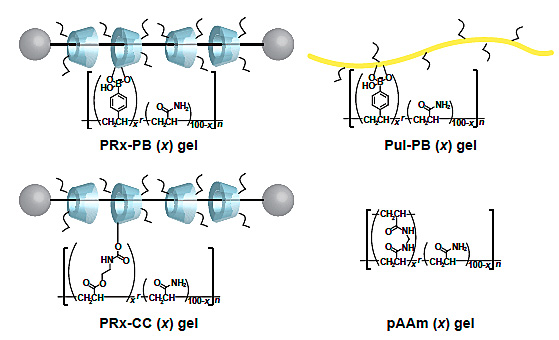March 18, 2021
Tag:
Cyclodextrins (CDs) are cyclic oligomers of α-1,4-d-glucopyranoside and are known mainly as hexamers to octamers. The central cavities of CDs can retain small molecules, enabling diverse applications. The smallest members, CD3 and CD4, have ring sizes too small to permit the most stable conformations of glucopyranose and have not been accessible synthetically. In this study, we present methods to chemically synthesize both CD3 and CD4. The main factor in the successful synthesis is the creation of a glucopyranose ring conformationally counterbalanced between equatorial- and axial-rich forms. This suppleness is imparted by a bridge between O-3 and O-6 of glucose, which enables the generation of desirable, albeit deformed, conformers when synthesizing the cyclic trimer and tetramer.

Cyclodextrins (CDs) are cyclic oligomers of d-glucose (1), and CD6 to CD8 (1) (Fig. 1A) are produced enzymatically in bulk (2), making them easily available and nontoxic (3–5). These properties, along with the ability of CDs to capture small molecules within their hydrophobic central cavities, have permitted diverse applications in industry, medicine, and consumer products. Larger CDs, up to CD35, have been characterized (6). Conversely, the smallest known CD formed through chemical synthesis is CD5 (2) (7). CD3 (3) and CD4 (4) have been discussed without the actual compounds being known. In 1957, French said that space-filling models of 3 to CD-infinity could be constructed when the glucose units had conformational flexibility and that the smallest CD produced by the treatment of glycogen with Bacillus macerans amylase was most likely CD6 (8). In 1970, Sundararajan and Rao reported, on the basis of computational calculations, that CDs having fewer than six glucose molecules could not be cyclized because of steric overlap (9). However, Nakagawa et al. synthesized 2 in 1994 (7). In the following year, Immel et al. indirectly concluded that the difficulty of the synthesis of 3 and 4 is due to the strained glucose units (10). Despite the synthesis of CD-like molecules with smaller rings (11–14), the synthesis of 3 and 4 remained an unmet goal. Here, we report the chemical synthesis of these small CDs.
In our synthesis of 3 and 4, one of the decisive factors for success was the adoption of the 3,6-O–EDB [1,1′-(ethane-1,2-diyl)dibenzene-2,2′-bis(methylene)] bridge (Fig. 1B), which was introduced to improve α-selective glycosylation using 5 (15, 16). The bridge in 5 arches over the β face of the pyranose ring and hinders the β face approach of an alcohol, yielding the corresponding product with high α selectivity under kinetic conditions with the use of Cp2ZrCl2 (where Cp is cyclopentadienyl) and AgClO4 in the presence of 4-Å molecular sieves (Suzuki glycosylation) (17). However, the bridge locked the pyranose ring into the 3S1 form, which directed the 2-O-benzyl group axially toward the α face, thus inducing adverse steric hindrance as in 6. The α selectivity and the yield of glucosides 7 therefore decreased with the use of elevated reaction temperatures and more sterically hindered alcohols. We suspected that this issue could be resolved by increasing the steric hindrance at the β face and reducing the overhang of the 2-O-benzyl group on the α face. To satisfy both of these requirements, we planned to modify the pyranose conformation by introducing a longer bridge than the o-xylylene group. With this consideration in mind, we chose an EDB group. The glycosylation reaction using the EDB-bridged glucosyl fluoride 8 afforded the corresponding glucosides with α selectivity even at room temperature [supplementary material sections 2 and 19 to 24 (SM-2, -19–24)]. The reaction proceeded through the corresponding oxocarbenium ion intermediate, as similar α selectivities were observed with 8-α and 8-β (SM-15, -16).
The other key element for synthesizing 3 and 4 was the discovery of the supple pyranose system. The most stable conformation of d-glucopyranose is 4C1. On the other hand, the attachment of a bridge between the two discontiguous oxygen atoms on the pyranose ring produces a bicyclic skeleton in which the newly formed ring modulates the conformation of the pyranose scaffold. A short bridge locks the conformation into a motif with more axial substituents, as seen in 5 and 7 (18) and others (19–23). By contrast, when the O-3 and O-6 atoms were bridged by the EDB group, the pyranose conformation was modified by subtle structural alteration (Fig. 1C), revealed by the 1H nuclear magnetic resonance (NMR) coupling constants of 8 to 12 (SM-8–14). Thus, although the difference between the diols 9-α and 9-β relates only to the anomers, the conformations of the pyranose moieties were in 1C4 and 4C1 forms, respectively. In the case of dibenzylated compounds 8 and 10 to 12, where the anomeric substituents were varied, the conformations of the pyranose systems were widely distributed, as displayed on a map of conformations that puts 1C4 and 4C1 forms on both poles (Cremer-Pople-Stoddart coordinates) (24, 25). We propose that the length of the EDB bridge is appropriate to equally balance the innate preference of glucose for the equatorial-rich 4C1 form and the tendency of the bridge to transform the pyranose ring into axial-rich forms. The α selectivity featured in the reaction using 8 and the supple pyranose ring set the stage for the synthesis of strained CDs.


Contact Us
Tel: (+86) 400 610 1188
WhatsApp/Telegram/Wechat: +86 13621645194
+86 15021993094
Follow Us:




 Pharma Sources Insight July 2025
Pharma Sources Insight July 2025


